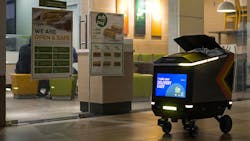Last-mile delivery workers that never need a break: Meet the Ottobots
LAS VEGAS—Ottobots, roll out. Sharing a similar name to the popular transforming robot heroes of the 1980s cartoon and film series of later decades, startup Ottonomy shared what its executives see as an answer to the workforce shortage at retailers and restaurant chains across the country: delivery robots.
The autonomous and contactless delivery company made its Consumer Electronic Show debut at CES 2022 to show off its 3-foot tall, four-wheeled, electric robots that are already rolling through the Cincinnati International Airport (CVG) in Covington, Kentucky. The robots deliver food and beverage orders from restaurants to travelers waiting at their gate.
The company envisions expanding its autonomous robots for curbside delivery at retailers’ and restaurants’ parking lots, Deepak Gupta, Ottonomy’s chief revenue officer, told FleetOwner during the international technology show at the Las Vegas Convention Center. The technology, he said, could strengthen private fleets for major retailers offering curbside delivery. He said the company hopes to announce a deal with a major box retailer soon.
With hourly workforce figures nearing $20 at some fast food and other retailers, Gupta said the robots could fill those jobs instead of people, offering reliable last-mile delivery all day long. “We offer you automated curbside delivery. So my robot goes inside the store, you load the order in it, then it rolls out to the parking lot where the customer is,” Gupta explained. “It can make about 10 to 15 deliveries per hour without the same human challenges—it doesn’t get sick, it doesn’t need a toilet break, it doesn’t stop to smoke a cigarette.”
According to Gupta, the Ottobot is the world’s first fully autonomous delivery robot at an airport. Along with partnering with CVG Airport, Ottonomy partnered with Los Angeles-based restaurant Crave for customer food delivery. In December 2021, Presto, a provider of restaurant automation technologies, announced that their partner restaurant guests would be able to order using Presto’s technology and have the food delivered via Ottonomy’s robots.
“The ongoing labor shortage is preventing restaurants from maximizing the revenue potential of digital channels,” said Rajat Suri, founder and CEO of Presto. “Restaurants often partner with third-party delivery channels, which can have a significant impact on net margin. In partnership with Ottonomy, we can enable restaurants to become more agile in managing staff deployments and associated costs.”
Ottobot pilots started running during the pandemic in 2020. The initial robot deliveries gathered additional research to develop the system. It currently has 10 in production, two working at CVG, and others tested in various scenarios elsewhere. Ottonomy will begin testing the robots in the snow at the Brooklyn Naval Yard, where it plans to open a new testing lab and office this month.
“With (automated) last-mile delivery, the typical focus is on fair-weather problems,” Gupta said. “You don’t really have solutions for adverse weather. We want to do testing in various weather conditions for our partners. So you choose California, it’s sunny; if you choose Texas or Arizona, test when it’s hot; if we do Florida, test in humidity; if you want to New York or Michigan, test in the snow; if you want to do Seattle, it’s rainy. So you choose, and I’ll be able to showcase that my robot can perform consistently in various conditions. And that will enable us to do a truly national rollout.”
Gupta noted that another benefit of these delivery robots is that they can be geofenced within private properties, such as parking lots. So they do not need to follow various regulations or get permits to operate on public roads.
The Ottobots create a digital map of the serviceable area, update its live location, and navigate autonomously to deliver the orders. Ottonomy's proprietary contextual mobility navigation software enables Ottobot to navigate crowded and unpredictable environments. Gupta said the startup provides a scalable and flexible solution for managing a fleet of robots deployed across different geographies.
To support its Ottobots roll out across North America over the next 18 months, Ottonomy formed a strategic partnership with ARO, a global leader in robotic management, operations, and support. ARO will support Ottonomy during its rollout, including implementation, daily operations, robotic fleet management, and complete robot lifecycle management.
Said Ritukar Vijay, CEO of Ottonomy, during its launch here in Vegas: “The pandemic has provided Ottobots a catalyst enabling a series of partnerships that allowed us to launch fully autonomous delivery for indoor deliveries, curbside deliveries, and last-mile deliveries.”
About the Author
Josh Fisher
Editor-in-Chief
Editor-in-Chief Josh Fisher has been with FleetOwner since 2017. He covers everything from modern fleet management to operational efficiency, artificial intelligence, autonomous trucking, alternative fuels and powertrains, regulations, and emerging transportation technology. Based in Maryland, he writes the Lane Shift Ahead column about the changing North American transportation landscape.



